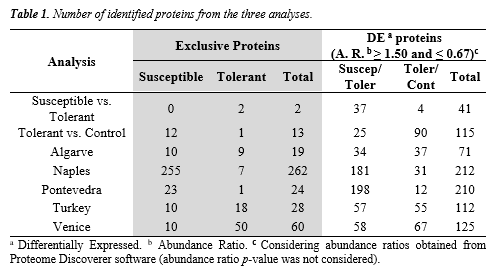SEARCH FOR BIOMARKERS OF RESISTANCE IN Ruditapes decussatus TO Perkinsus olseni PARASITE INFECTION
Introduction
The grooved carpet shell (Ruditapes decussatus) is a bivalve mollusc species with a distribution from NE-Atlantic coast and Mediterranean Sea. This species is highly desirable and sold at high prices being Portugal the top-seller (FAO, 2020). A decline on the species happened since the 90´s due to biotic and abiotic factors, such as parasite infection and degradation of the environment. Infection by Perkinsus olseni parasite is the main biotic factor that causes decrease of populations. It was first diagnosed in the 1980s, after introduction of the invasive species Ruditapes philippinarum from Asia for intensive production in Europe (Vilas et al., 2011). It has been observed that Perkinsus causes changes in humoral and cellular responses and rise of mortality in infected individuals. Epizootic studies indicates that temperature and salinity influence host-parasite interaction, especially in adults. Despite of lacking an adaptive immune system, this species has demonstrated to thrive in highly affected areas, reaching adult phase and surviving high parasite prevalence (Villalba et al., 2004).
Several studies focused on host-parasite early interaction and markers of resistance (Fernández-Boo et al., 2016; Hasanuzzaman et al., 2017; Cruz et al., 2020), while none addressed the presence of tolerance/susceptibility signatures in different populations. Thus, this study seeks to identify markers of tolerance/susceptibility in populations of R. decussatus affected by P. olseni by looking at the haemolymph´s proteome profile of tolerant individuals in comparison with susceptible ones.
Materials and Methods
Five populations with high prevalence of the parasite across Europe namely, Pontevedra (Spain), Algarve (Portugal), Naples (Italy), Venice (Italy), and Izmir (Turkey) were sampled. A Perkinsus-free population (Noia, Spain) was used as control.
After Perkinsus diagnosis and haemolymph extraction, 5 individuals highly infected (susceptible) and 5 individual non- or low-infected (tolerant) were chosen at each population for a proteomics analysis by LC-MS. Three analyses were considered to identify markers of tolerance/susceptibility: i) Tolerant vs. Susceptible (in all populations); ii) Tolerant (in all populations) vs. Control (Noia population); iii) Tolerant vs. Susceptible (at each population). Expressed and exclusive proteins were identified according to Osório et al., 2021. Functional annotation was performed on identified protein from all analyses to pinpoint the expression profiles using the Blast2Go software.
Results and discussion
A substantial number of exclusive proteins was identified in the Naples population, followed by Pontevedra. The same tendency was observed in the differentially expressed proteins, being the number of predominant in the susceptible individuals in both exclusive and differentially expressed proteins (Table 1). These results indicate a higher response on affected individuals from these populations to parasite infection. Functions related to metabolism were most represented in susceptible than in tolerant individuals suggesting a higher production of energy to counteract the infection. Also, six proteins were differentially expressed in all tolerant individuals and seem to be possible markers of tolerance to P. olseni infection.
These results point towards a host generated tolerance suggesting an existence of adaptation mechanisms to parasite.
Acknowledgements
This research was supported by the project Tools4Breed – Challenge test and genetic markers for Perkinsus as a tool for Ruditapes decussatus´ selective breeding with reference FA_05_2017_025 financed by Fundo Azul and República Portuguesa. João Estêvão was supported by FA_05_2017_025 and by FCT UI/BD/150906/2021 grants.
References
Cruz, A. et al., 2020. Genetic variability in ruditapes decussatus clam combined with Perkinsus infection level to support founder population selection for a breeding program. PeerJ 8, e9728.
FAO, 2020. The State of World Fisheries and Aquaculture 2020, The State of World Fisheries and Aquaculture 2020. FAO.
Fernández-Boo, et al. 2016. Protein expression profiling in haemocytes and plasma of the Manila clam Ruditapes philippinarum in response to infection with Perkinsus olseni. J. Fish Dis. 39, 1369–1385.
Hasanuzzaman, A.F.M. et al., 2017. Transcriptomic profile of Manila clam haemocytes in response to Perkinsus olseni infection. Aquaculture 467, 170–181.
Osório, H. et al., 2021. Proteomics Analysis of Gastric Cancer Patients with Diabetes Mellitus. J. Clin. Med. 10, 407.
Vilas, R. et al., 2011. Very low microsatellite polymorphism and large heterozygote deficits suggest founder effects and cryptic structure in the parasite Perkinsus olseni. Infect. Genet. Evol. 11, 904–911.
Villalba, A. et al., 2004. Perkinsosis in molluscs: A review. Aquat. Living Resour. 17, 411–432.
